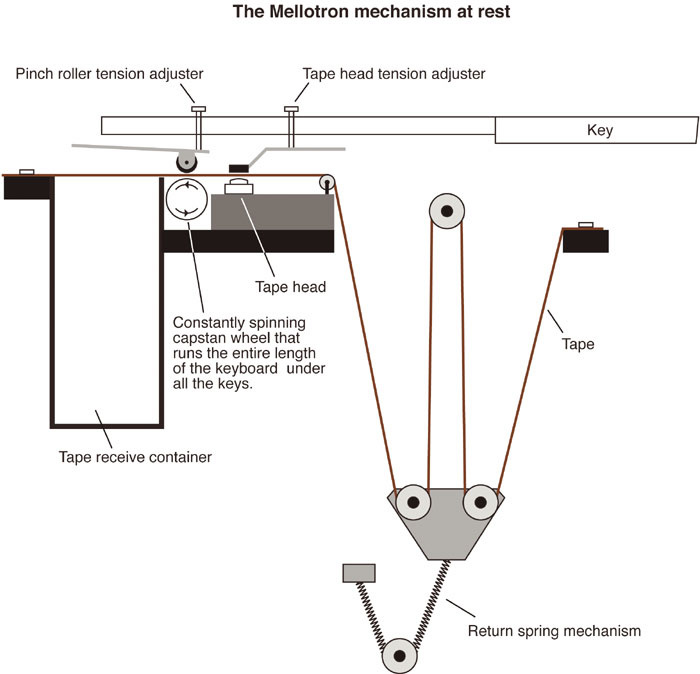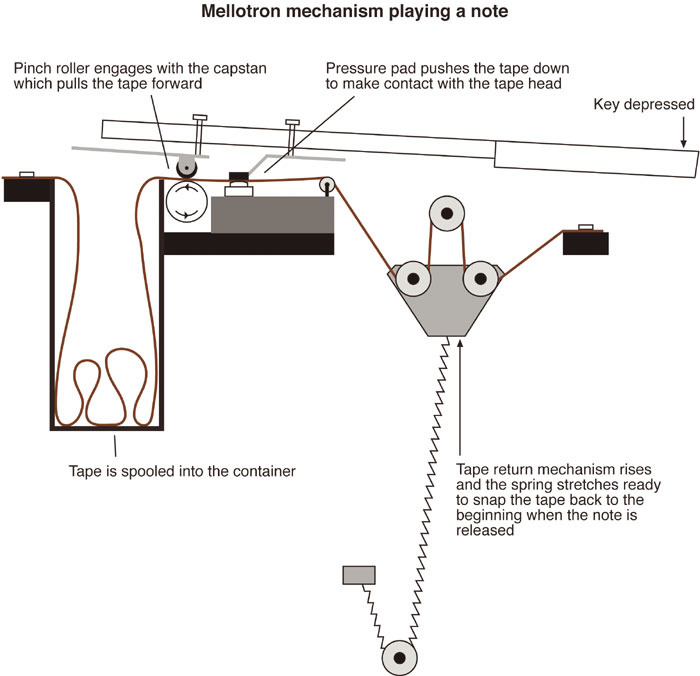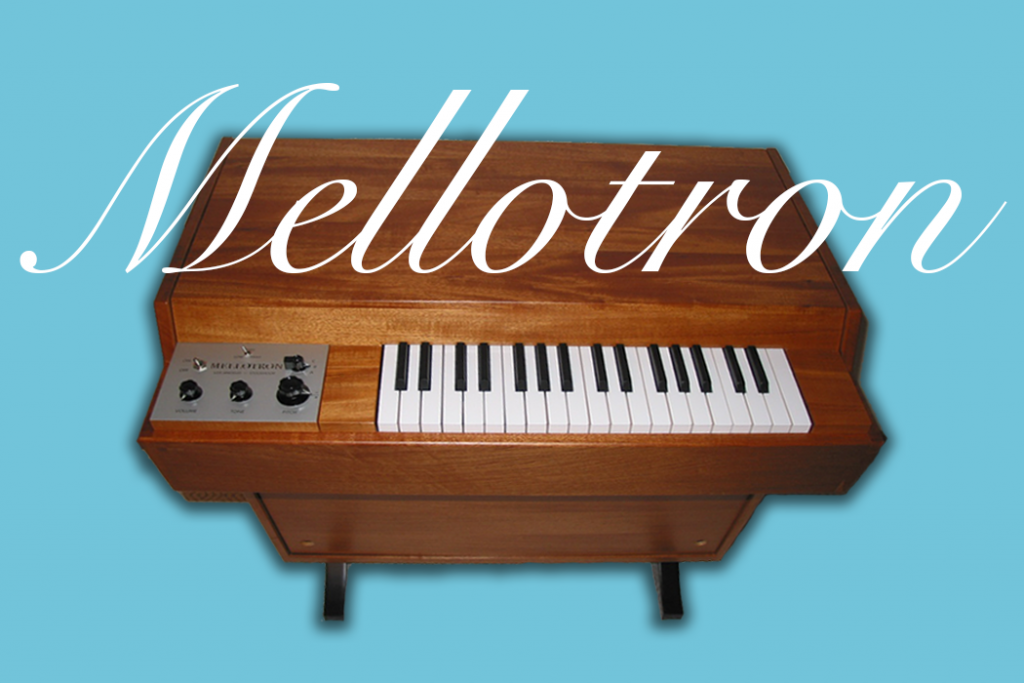+ Ryan Lott (of Son Lux) teaches how to build custom virtual instruments for sound design and scoring in Designing Sample-Based Instruments.
Pipe organs are expensive. They’re such large installations that they’re as much architectural and carpentry projects as they are musical instruments, and therefore out of reach of most individuals and small institutions. Engineer and inventor Laurens Hammond searched for a cheaper alternative with his tonewheel organs in the 1930s.
But while these instruments are pretty cool in their own right, they don’t sound very much like pipe organs.
A decade or so later, while entertaining himself with his home organ, inventor Henry Chamberlin came up with the idea for a different tack — to make numerous short recordings of real instruments on then-cutting-edge magnetic tape and have each key on a keyboard trigger a recording of the chosen instrument playing that same note. In essence, Chamberlin imagined the world’s first sampling keyboard.
In a period of years spanning the mid-1940s into the 1950s, Chamberlin set about developing, marketing, and refining his idea. With a Neumann U47 microphone in his home project studio, he exclusively contracted members of the Lawrence Welk orchestra to provide the sampled notes of various instruments.
In addition to single notes playable on a keyboard, the Chamberlin also offered sampled loops of rhythm accompaniment (a feature that influenced organ makers like Baldwin, Hammond, and Lowrey to devise similar features).
Named after its inventor, the first Chamberlin came to market in 1948 but did not become a viable commercial product until the early 1950s. Despite objections from the American Federation of Musicians (who were concerned it might put musicians out of work), the business slowly grew, and salesman Bill Fransen came onboard.
On a trip to the UK to seek an OEM manufacturer of playback heads (with two Chamberlin Model 600s in tow), Fransen connected with electronics manufacturer Bradmatic, Ltd. Intrigued with the design, the owners of Bradmatic believed they could improve upon it and asked if they could purchase the design from Fransen. Without Chamberlin’s knowledge, Fransen agreed. When Henry Chamberlin got wind of this, he was understandably upset — but ultimately, a non-exclusive deal was reached, and the Mellotron (manufactured by Bradmatic Ltd; later Streetly Electronics) was born.
Chamberlins still continued to be manufactured, but the Mellotron, with its somewhat-better mechanical engineering, was the better seller. (Thanks in part, perhaps, to ads like this one below!)
Chamberlins and earlier Mellotrons were not designed to be portable. The Mellotron M400, however, was the most road-worthy of them all, and by far the best seller. It was introduced in 1970, so while it’s the most common Mellotron (and the one with the iconic white-cabinet dress), it’s not the model used on famous 1960s-era recordings by the Beatles, the Zombies, and the Moody Blues.
Sir Paul McCartney demonstrates a double-manual Mellotron MKII. The left-hand manual triggers pre-recorded accompaniment loops.
The 35-key, single manual M400 had removable tape frames with three sounds each, and the frames can be swapped in three-to-five minutes to install a different set of three sounds.
Each key has its own length of three-track magnetic tape (an unusual 3/8” in width) and its own complete tape player with a playback head, capstan, pinch roller, and tension mechanism. Each of the tape’s three 1/8”-wide tracks has one instrument sound (three sounds per tape), and as the “A/B/C” selector switch on the front panel is moved, the playback heads are physically repositioned under the tapes to align with the chosen sound.
Contrary to popular belief, the Mellotron does not make use of tape loops, but rather fixed lengths of tape (about seven-to-eight seconds in duration) for each note. As the key is depressed, tension is applied to the tape, and it’s pulled across the playback head and deposited in a temporary storage bin. When the key is released, a spring mechanism automatically rewinds the tape.
The following graphics, courtesy of Sound on Sound, are great illustrations.


A “pitch” control allows fine adjustment of tape speed (and therefore tuning). Tone and volume controls round out the front panel on an M400. After Streetly went out of business in 1986, the Mellotron trademark changed hands a few times, ultimately landing in the hands of American David Kean.
Kean partnered with Swedish enthusiast Markus Resch, and Mellotrons are once again being manufactured along with some new models (as well as a few additional features). The tape sources remain the same — including some original Chamberlin sounds like “three violins” (which has survived as part of the Mellotron legacy all along). Streetly was also revived and produces a competing machine.
+ Enjoy access to Soundfly’s suite of artist-led music learning content for only $12/month or $96/year with our new lower price membership. Join today!

Due to the rather primitive tape mechanism (and the inherent challenges of keeping 35 playback heads and pinch rollers in good condition), Mellotrons are a little unpredictable and can be quite characterful. The action of the keyboard is stiff and unusual-feeling, so virtuosic playing is not usually in the cards.
All of these “bugs” somehow become “features,” however — the quirks add up to a sonic character that’s iconic and instantly recognizable!
A Soundfly Mellotron Playlist
The Beatles – “Strawberry Fields Forever”
Mellotron flutes in full display on the intro; perhaps the most iconic of all Mellotron tracks!
Led Zeppelin – “Stairway to Heaven”
Mellotron flutes played by John Paul Jones.
Radiohead – “Exit Music (For a Film)”
A very dry and up-front recording of the “eight-voice choir” sound.
Oasis – “Wonderwall”
Many assume that “Wonderwall” features a real violoncello (and the video doesn’t do anything to dispel the notion!), but it’s actually a Mellotron on the “solo cello” sound. An interesting bit of trivia about this tape set is that the very bottom notes were actually played on a double bass, as ‘cellist Reginald Kirby refused to re-tune his ‘cello on the session!
David Bowie – “Space Oddity”
Rick Wakeman plays Mellotron here in what was allegedly supposed to be a scratch track temporarily standing in for an eventual orchestral overdub. For one reason or another, the Mellotron remained as well.
The Beatles – “The Continuing Story of Bungalow Bill”
This is an unusual one — the Spanish guitar introduction here is a bit from one of the early Mellotron accompaniment tapes. Prior to the M400, most Mellotrons had two manual keyboards — one for playing single notes, and one that triggered variously styled accompaniment patterns.
Tangerine Dream – “Phaedra”
This 17-minute opus begins mostly with Moog synthesizer but eventually incorporates liberal use of Mellotron strings and voices.
King Crimson – “The Wake of Poseidon”
Lots of Mellotron strings and voices throughout.
Genesis – “Watcher of the Skies”
The extended introduction is entirely layered Mellotron with string-and-brass sounds.
The Zombies – “Changes”
Along with “Strawberry Fields” and “Stairway,” this introduction is one of the more famous uses of Mellotron flutes.
Roxy Music – “Ladytron”
Lots of the Mellotron’s famous “three violins” sound here! This sound set actually dates all the way back to the Chamberlin. A famous Easter egg in this sound (subtle and not audible here) is that one of the notes contains an errant chair scrape; a violinist’s chair must’ve moved during the take!
Ready for even more?
Check out Soundfly’s variety of courses on songwriting, mixing, beat making, recording, composing, and more, led by artists like Kimbra, Com Truise, Jlin, Kiefer, The Pocket Queen, and RJD2: From Samples to Songs.




